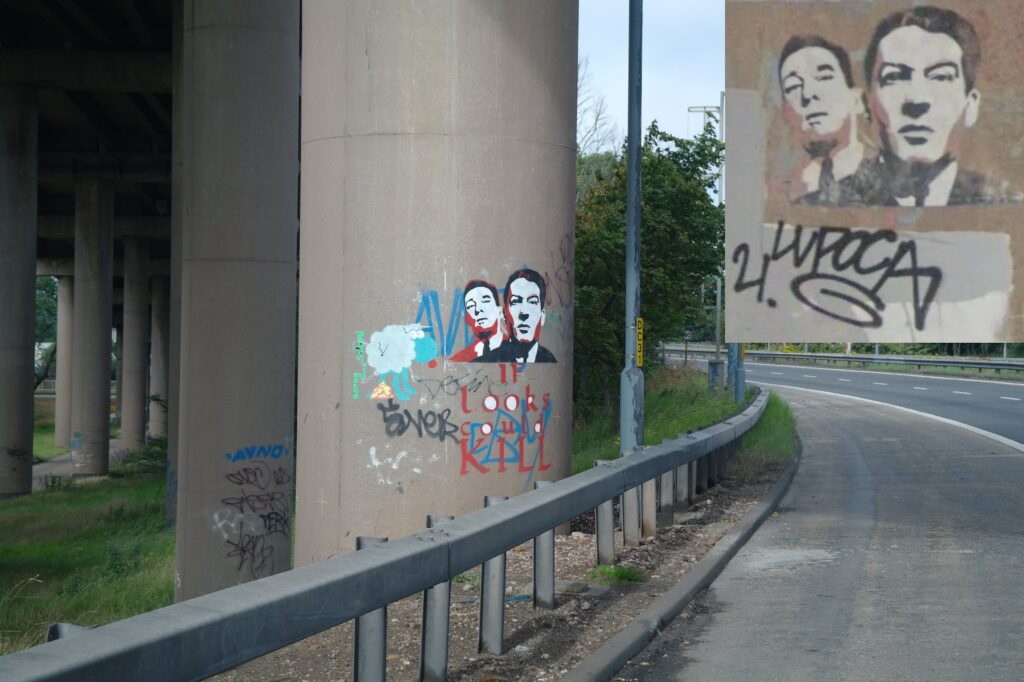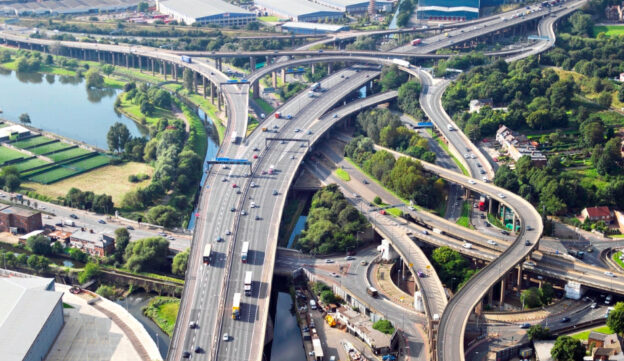In the heart of England, where motorways snake and twist through Birmingham, there lies a structure that transcends the ordinary into the extraordinary. Its official name is the Gravelly Hill Interchange, but to the millions who traverse it, to those who marvel at its intricate design, and those who swear at missing their turning, it is simply known as Spaghetti Junction. Its beauty is terrible to behold, like the Angels of old, and is truly Ballardian. More than a mere motorway interchange, Spaghetti Junction is, in many ways, the greatest piece of post-modern art. Ever.
But what makes Spaghetti Junction so special? It’s brutal, ugly, terrible even, but it’s also home. The wonder that is the Gravelly Hill Interchange, is its beauty.
A Childhood in Nechells: Holborn Hill and School Days
To a boy born and brought up in Nechells, living under the shadow of Spaghetti Junction during my most formative years, it was the most beautiful thing I had ever experienced, outside the faces of my Mom and Nan. I still marvel at its abstract beauty today, the gateway to my Dad’s beloved Aston Villa (although he could get a tiny bit Golden Gordan). And Spaghetti Junction felt like “ours”, a gritty, grandiose piece of art connected to my family’s Irish immigrant roots and the countless Irish “navvies” who laboured to build it.
Holborn Hill was my daily route to and from Eliot Street School after we moved to “Six Ways,” the vibrant intersection of Lozells, Handsworth, Newtown, and Aston. As a child of five to eleven, I’d walk up and down that hill every day, often accompanied by my Mom and sometimes with my teacher, Miss Jean Leason, who encouraged my Mom to keep me focused academically. That journey was as much a foundation as the concrete pillars of the junction itself, a memory of ambition set against the bustling landscape of our neighbourhood.
Not Simply Complicated: A Monument to Complexity
Built between 1968 and 1972, Spaghetti Junction, officially the Gravelly Hill Interchange or Junction 6 on the M6, is an engineering marvel designed to accommodate the convergence of five motorways and countless local roads. The term “Spaghetti Junction” is believed to have been coined by a journalist at the Birmingham Evening Mail. In the Evening Mail on 1 June 1965, journalist Roy Smith described plans for the junction as “like a cross between a plate of spaghetti and an unsuccessful attempt at a Staffordshire knot.” Sub-editor Alan Eaglesfield took this and coined the now-famous headline “Spaghetti Junction.” However, the Mail may not have been the sole origin of the name; some suggest that Councillor Charles Simpson, a local authority member, gave it the nickname in a planning meeting, inspired by an earlier “Spaghetti Junction” in Los Angeles, known more critically as “Malfunction Junction.” The truth may remain as tangled as the roads themselves.
Opened in 1972 by then Environment Secretary Peter Walker, this junction saw the M6, A38, and A5127 meeting, an intricate web of connections held up by nearly 600 concrete columns. Costing £10 million to build, Spaghetti Junction was the last piece of the 1960s motorway network in this area, transforming the local landscape forever. The entire structure spans a three-and-a-half-mile-long viaduct that carries the motorway over railways, canals, and industrial zones, physically lifting traffic above Birmingham’s infrastructure, much of which traces back to the Industrial Revolution. With its dizzying array of soaring bridges and sweeping curves, the structure is a masterclass in controlled chaos. It doesn’t just serve as a vital transport hub; it reflects the post-modern ethos of complexity, contradiction, and an embrace of disorder.
Its sprawling, layered form is reminiscent of the frenetic nature of modern life. Roads weave over and under each other like tangled strands of spaghetti, representing the interconnectivity and fragmentation of the post-modern era. There’s no single path to follow; instead, drivers are offered multiple routes, like the choices we constantly navigate in today’s fast-paced world.
Beneath this grandeur lies a peculiar “beach” where the Grand Union, Tame Valley, and Birmingham & Fazeley canals converge. There’s no sand, but locals sit and gaze at the concrete tangle above, a meeting place in the heart of Birmingham’s own underworld.
A Labyrinth of Mystery: Navigating Spaghetti Junction
Spaghetti Junction has a reputation for being a driver’s nightmare, even among locals who’ve navigated its tangled routes for years. Many people joke that getting through the interchange is an exercise in patience and a test of one’s sense of direction. With its maze-like structure and countless entrances and exits, it’s no wonder many say it’s impossible to navigate on the first try.
Mystery abounds at Spaghetti Junction, and it’s not uncommon to hear drivers claim that certain exits seem to lead nowhere or end abruptly, like a road to a hidden world. This almost mythical confusion has spawned countless tales of “mystery” exits, with some roads seemingly disappearing into the mass of concrete only to reappear elsewhere. For newcomers, Spaghetti Junction is like a twisted initiation into Birmingham, as they struggle to choose the right path and avoid becoming lost in its concrete embrace.
For many, navigating Spaghetti Junction is a rite of passage in Birmingham driving, and the tales of “lost souls” who took the wrong turn add to the structure’s reputation. It’s as though the architects, in their post-modern zeal, left us a puzzle to solve with each journey.
Beyond Utility: An Artistic Achievement
On the surface, Spaghetti Junction may seem to be a purely functional entity, a means to get from Point A to Point B. But like all great works of art, its true value lies in what it symbolises. The post-modern era has often been defined by the breakdown of grand narratives, the rejection of absolute truths, and the celebration of ambiguity. In Spaghetti Junction, we see this artistic philosophy brought to life in concrete and steel.

The structure even carries tales of ghosts and gangsters. Local legend says the 559 columns entomb enemies of the Fewtrell family, known for defending Birmingham’s turf from the Kray Twins. One memorable piece of graffiti once depicted the Krays with the phrase, “If looks could kill,” scrawled beneath, an icon of Birmingham’s gritty past.
Bill Drummond of the KLF famously dubbed it “the entrance to the underworld,” recounting his night spent stranded beneath it in 1973. “It was nighttime, raining…all very scary,” he said. Drummond’s view of Spaghetti Junction mirrors its mythic quality, a place where fear and fascination converge. The song “Hot Asphalt” by the Dubliners might be the perfect tribute here, a wink to the gritty Irish legacy of those who built it.
The Sublime in the Everyday
Spaghetti Junction is more than an interchange; it’s a metaphysical portal to another land, a gateway to the Nechells of my childhood, a place of bombed-out post-war ammunition factories and “bombpecks”, a word foreign to anyone beyond the post-war denizens of Nechells, a remnant of a past erased by the urban renewal projects of the 80s. It’s a portal to another time, an age long past, like the ancient barrows and mounds of the Sidhe, Elves, and the enchanted hills of Tam Lin. It carries with it a mythology that still speaks to us in our dreams, anchoring the myths of my youth in the stone and steel of the Post War renewal.
Post-modern art often seeks to blur the boundaries between high art and everyday life, between the sacred and the mundane. Spaghetti Junction does exactly that. It turns a utilitarian motorway interchange into a thing of beauty, into something more than the sum of its parts. It challenges us to find the sublime in the ordinary.
To stand beneath Spaghetti Junction is to feel dwarfed by the scale of modern infrastructure, much like standing before a grand cathedral or towering sculpture. But instead of evoking religious awe, it speaks to our awe of human ingenuity and the man-made world. The rhythm of the traffic, the interplay of light and shadow through its concrete beams, the constant motion, these create a living, breathing canvas that changes by the minute. It is art that is experienced rather than observed, a piece of modern-day theatre where everyone, whether they realise it or not, becomes a performer.
A Beacon of Brutalism
Spaghetti Junction’s brutalist architecture, with its exposed concrete and unapologetic bulk, is a defining characteristic of its time. In the post-modern tradition, it rejects traditional ideas of beauty. It is not smooth or sleek. It is raw, and unfinished, a reflection of the post-war era’s desire for practicality over decoration. Yet, within its brutalism lies a certain elegance, a testament to the skill of the engineers and architects who designed it.
Brutalism, once criticised for its harshness, has undergone a revival in recent years as a symbol of honesty in construction, where the materials are not hidden but celebrated. Spaghetti Junction, with its unapologetic use of concrete, stands as a beacon of this architectural philosophy. It reminds us that beauty can be found not in decoration but in the sheer force of functionality and purpose.
Conclusion: Art in the Age of Infrastructure
In an age when art is often confined to galleries and museums, Spaghetti Junction challenges the very notion of where art begins and ends. It forces us to confront the beauty in infrastructure, to see the artistic potential in the roads and bridges we use every day. It is a piece of post-modern art that is experienced by millions without them even realising it, subtly shaping their perceptions of the world around them.
Bill Drummond’s words resonate: “Spaghetti Junction is the entrance to the underworld.” In this sense, Spaghetti Junction is more than just a motorway interchange. It’s a symbol of our time, a time when complexity, ambiguity, and interconnectedness define our existence. For those of us who grew up under its shadow, it’s also a symbol of identity, pride, and the art that lives in our everyday lives. In this sense, it truly is the greatest piece of post-modern art. Ever.
